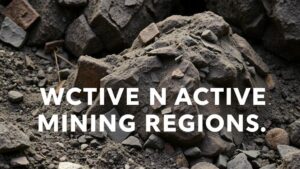Identifying Gold-Bearing Clay Layers in Overburden Soil Profiles
Identifying Gold-Bearing Clay Layers in Overburden Soil Profiles
The presence of gold in various geological settings across the globe has led to increased interest in the identification of gold-bearing clay layers within overburden soil profiles. This article explores methods to detect these layers, guiding mineral exploration with a clear focus on geological and analytical principles.
The Importance of Overburden Soil Profiles
Overburden refers to the layers of soil and rock that lie above a mineral deposit. In the context of gold mining, understanding the composition and structure of overburden is crucial. Gold-bearing clays can indicate the presence of underlying mineral wealth, making their identification a vital step in exploration and mining operations.
Understanding Clay Properties
Gold-bearing clays exhibit unique properties that distinguish them from non-mineralized clays. Key characteristics include:
- Mineral Composition: Gold-bearing clay often contains specific minerals such as kaolinite, illite, and montmorillonite, which may serve as indicators of gold deposits.
- Color and Texture: Clays rich in gold tend to exhibit distinctive colors, such as reddish or yellowish hues, and a finer texture compared to surrounding soils.
- Conductivity: The electrical conductivity of clay can vary based on its mineral content, providing geophysicists with valuable data when characterizing prospective areas.
Techniques for Identifying Gold-Bearing Clays
Various techniques can be employed to identify gold-bearing clay layers within overburden soil profiles. These methods often complement one another and provide a more comprehensive understanding of the geological setting.
1. Geological Mapping
Field studies and geological mapping allow geologists to identify areas with potential gold mineralization. By analyzing rock formations, fault lines, and sediment patterns, experts can assess which locations may contain gold-bearing clays.
2. Soil Sampling and Analysis
Collecting soil samples at varying depths helps determine the distribution of clay layers. Advanced analytical techniques, such as X-ray fluorescence (XRF) spectroscopy, enable precise identification of elemental content within the soil, allowing for the detection of gold concentrations and other valuable minerals.
3. Geophysical Methods
Geophysical techniques, such as ground-penetrating radar (GPR) and electrical resistivity tomography (ERT), are invaluable for visualizing subsurface structures. These methods can reveal variations in conductivity and stratification, indicating potential gold-bearing horizons hidden beneath overburden.
Case Studies
Several successful mineral exploration projects illustrate the effectiveness of identifying gold-bearing clay layers within overburden. One notable example is the exploration of the Carlin Trend in Nevada, USA, where clays enriched with gold were correlated with specific geological features, leading to significant discoveries.
Also, in regions of Western Australia, soil sampling identified gold-bearing clays within alluvial deposits, feeding into the targeting of larger ore bodies beneath the surface. In both cases, a multidisciplinary approach yielded positive results, emphasizing the importance of employing various detection techniques.
The Role of Statistical Analysis
Statistical analysis can enhance the identification process by correlating soil data with known gold occurrences. Utilizing geostatistical methods, such as kriging, allows geologists to model ore body distributions and predict potential clay mineralization patterns effectively.
Actionable Takeaways
- Conduct thorough geological mapping and analysis to identify favorable exploration areas.
- Employ soil sampling in conjunction with advanced analytical and geophysical techniques to detect gold-bearing clays.
- Use statistical methods to enhance the interpretation of soil data and improve mineral exploration strategies.
Conclusion
The identification of gold-bearing clay layers in overburden soil profiles is a nuanced process that combines geological understanding, analytical techniques, and statistical modeling. By leveraging these tools, mineral exploration can be more targeted and efficient, ultimately leading to successful discoveries in the quest for gold.

